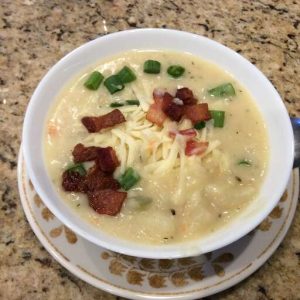Potato soup, a staple in many cultures, offers comfort and warmth, especially during the cooler months. This dish, known for its creamy texture and hearty ingredients, has evolved over time, adapting to various culinary traditions. Originating from simple, humble beginnings, potato soup has become a beloved comfort food worldwide. Its versatility allows for endless variations, making it a favorite among home cooks and chefs alike.
Popular Potato Soup Recipes
Varieties of Potato Soup
It comes in many delicious forms. The classic creamy one, rich and smooth, often features a blend of potatoes, cream, and butter. Vegan one, on the other hand, uses plant-based ingredients for a healthier twist. Baked potato soup, loaded with toppings like cheese and bacon, mimics the flavors of a baked potato. Each variety offers a unique taste experience, showcasing the potato’s adaptability.
Classic Creamy Potato Soup
Classic Creamy Potato Soup is a timeless favorite, known for its rich and velvety texture. This soup typically starts with a base of diced potatoes, onions, and garlic, simmered in chicken or vegetable broth until tender. Cream or milk is then added for richness, along with butter for extra smoothness. Seasonings like salt, pepper, and fresh herbs are used to enhance the flavors. Often garnished with chives, grated cheese, or crispy bacon bits, this soup is a comforting bowl of warmth, perfect for chilly evenings.
Vegan Potato Soup
Vegan Potato Soup offers a plant-based take on the classic, ensuring everyone can enjoy this comforting dish. It uses vegetable broth as the base and incorporates creamy elements like coconut milk or almond milk to replace dairy. Nutritional yeast can be added for a cheesy flavor without the cheese. This version often includes a variety of vegetables, like carrots and celery, making it not only delicious but also nutrient-rich. Garnish with green onions and vegan cheese for a delightful finish.
Baked Potato Soup
Baked Potato Soup is a heartier version that encapsulates all the flavors of a fully loaded baked potato. This indulgent soup includes chunks of baked potatoes, sour cream, shredded cheese, and crispy bacon. Some recipes call for scooping out the baked potato flesh and adding it to a creamy soup base, while others use the potatoes whole. It’s a rich and satisfying meal, often topped with green onions and extra bacon, for a dish that’s sure to please.
Additional Varieties
There are numerous other varieties of potato soup to explore. For instance, Potato Leek Soup combines the subtle sweetness of leeks with potatoes for a light yet flavorful dish. Spicy Potato Soup adds a kick with ingredients like jalapeños or chili powder. For a heartier meal, some recipes include meat, such as ham or sausage, making the soup a more substantial option. Each variety offers a unique twist on the classic potato soup, catering to a wide range of tastes and preferences.
For those who love hearty and comforting soups, explore the classic Chicken Pot Pie Soup, a dish that shares the same soul-warming qualities as a traditional potato soup.
Key Ingredients and Their Benefits
Exploring Key Ingredients
The key to a great potato soup lies in its ingredients. Russet or Yukon Gold potatoes are ideal for their starchy quality and creamy texture. Potatoes not only provide essential nutrients like vitamin C and potassium but also give the soup its satisfying heartiness. Supporting ingredients like onions and garlic add depth to the flavor, while herbs and spices add warmth and complexity.
Types of Potatoes Best for Soup
When selecting potatoes for soup, the type of potato can significantly impact the texture and flavor of the dish. Starchy potatoes like russets are ideal for creamy soups due to their high starch content, which helps thicken the soup naturally. They break down easily when cooked, lending a smooth texture to the soup. Waxy potatoes, such as red or Yukon gold, maintain their shape better and are perfect for chunkier soups where you want the potatoes to remain intact. Yukon Golds, with their naturally buttery flavor, can add richness to the soup.
Health Benefits of Potatoes
Potatoes are more than just comfort food; they offer several health benefits. They are a good source of vitamins C and B6, potassium, and fiber, especially when eaten with the skin on. Potatoes also contain antioxidants that can help prevent cellular damage. Their high fiber content aids in digestion and helps in maintaining a healthy gut. Additionally, potatoes provide complex carbohydrates, which offer a steady release of energy, making them a satisfying and energy-boosting ingredient in soups.
Supporting Ingredients (Onions, Garlic, etc.)
Supporting ingredients like onions and garlic are essential in building the flavor base for potato soup. Onions add a natural sweetness when sautéed, enhancing the overall taste profile of the soup. Garlic contributes a pungent, earthy flavor that complements the potatoes well. Other common ingredients include celery and carrots, which add depth and a hint of sweetness. Herbs such as thyme, rosemary, or bay leaves can infuse the soup with aromatic flavors. For a creamy texture, milk, cream, or a roux (a mixture of butter and flour) are often used.
After enjoying a savory bowl of potato soup, why not indulge in a sweet treat? Discover the irresistible charm of Slutty Brownies, the perfect dessert to follow a comforting meal.
Cooking Techniques and Tips
Mastering Potato Soup
Achieving the perfect potato soup involves some essential cooking techniques. Slowly simmering the potatoes ensures they become tender and flavorful. It’s crucial to avoid overcooking, as this can lead to a gluey texture. Blending the soup to the right consistency is also key; a hand blender can create a smooth, velvety finish without overprocessing.
Best Practices for Cooking Potato Soup
- Choosing the Right Potatoes: Select the appropriate type of potato based on the desired soup texture. Russet potatoes are great for a creamy soup, while Yukon gold or red potatoes are ideal for chunkier soups.
- Consistent Potato Size: Cut the potatoes into uniform sizes to ensure even cooking. Uneven pieces can lead to some potatoes being overcooked and mushy, while others remain undercooked.
- Sautéing Aromatics: Begin by sautéing onions and garlic to release their flavors before adding the potatoes. This step lays the foundation for a flavorful soup.
- Simmering, Not Boiling: Gently simmer the soup rather than boiling it vigorously. Boiling can break down the potatoes too quickly and make the soup starchy.
- Seasoning in Stages: Season the soup in stages. Start with a light seasoning at the beginning and adjust towards the end of cooking to ensure the flavors are balanced.
- Blending Carefully: If blending the soup for a creamy texture, do so cautiously. Over-blending can make the soup gluey.
Common Mistakes to Avoid
- Overcrowding the Pot: Avoid adding too many potatoes, as this can prevent them from cooking evenly and make the soup too thick.
- Ignoring the Base: Don’t rush the initial steps of cooking the aromatics. A well-cooked onion and garlic base is crucial for flavor development.
- Forgetting to Stir: Regular stirring is important, especially if dairy is added, to prevent the soup from sticking to the bottom of the pot and burning.
- Overcooking the Potatoes: Be mindful not to overcook the potatoes, as they will continue to soften even after you turn off the heat.
- Skimping on Garnishes: Don’t underestimate the power of garnishes. Fresh herbs, a dollop of sour cream, or crispy bacon bits can elevate the soup significantly.
By following these best practices and avoiding common pitfalls, you can ensure your potato soup is delicious, with the perfect balance of flavors and textures.
Balance your meal with a healthier dessert option. Check out these delicious and healthy cookie recipes which can be the perfect light and nutritious end to a meal featuring potato soup.
Customizing Your Potato Soup
Customization Ideas
Customizing potato soup allows for creativity in the kitchen. For dietary adaptations, ingredients like coconut milk can replace cream in vegan versions. Adding proteins like chicken or vegetables like broccoli can transform the soup into a more substantial meal. Experimenting with toppings and mix-ins like cheese, bacon, or chives can also elevate the dish, adding both flavor and texture.
Variations for Dietary Needs
Gluten-Free Potato Soup
For a gluten-free version of it, ensure that all ingredients, including broth and seasonings, are gluten-free. Instead of using a traditional roux (made with flour) for thickening, opt for alternatives like cornstarch or a gluten-free flour blend. Another method is to puree a portion of the cooked potatoes to naturally thicken the soup without the need for flour.
Vegan Potato Soup
To make vegan one, replace the chicken or vegetable broth with a vegan-friendly version and use almond, soy, or coconut milk instead of dairy milk or cream. For creaminess without dairy, blending cooked cashews or using a dairy-free cream alternative works well. Nutritional yeast can be added for a cheesy flavor, and plant-based butter can be used for sautéing.
Adding Proteins and Vegetables
Incorporating Proteins
Adding proteins to potato soup can transform it into a more filling meal. For non-vegetarian options, cooked bacon, diced ham, or shredded chicken are popular choices. For a vegetarian protein boost, consider adding white beans, lentils, or chickpeas, which complement the flavors and add texture.
Including Vegetables
Vegetables can add both nutrition and variety to potato soup. Common additions include carrots, celery, and leeks, which should be sautéed along with the onions at the beginning. For a different flavor profile, consider adding spinach, kale, or Swiss chard towards the end of cooking. Roasted red peppers or sun-dried tomatoes can also provide a unique twist to the classic one.
These variations not only cater to different dietary needs and preferences but also offer an opportunity to experiment with flavors and ingredients, making it a versatile and enjoyable dish for everyone.
Serving and Pairing Suggestions
Serving and Pairing
When serving it, consider complementing it with crusty bread or a fresh salad for a balanced meal. These accompaniments not only add variety in texture but also enhance the overall dining experience. For beverage pairings, a light white wine like a Chardonnay or a crisp Pinot Grigio can beautifully balance the creaminess of the soup. For non-alcoholic options, a sparkling apple cider or an herbal tea can be refreshing choices.
Ideal Accompaniments
Potato soup, with its rich and comforting nature, pairs beautifully with a variety of accompaniments that can enhance its flavors and textures:
- Crusty Bread or Rolls: A slice of warm, crusty bread or soft dinner rolls are perfect for dipping into the soup and soaking up its creamy goodness.
- Green Salad: Serve a fresh green salad with a light vinaigrette alongside the soup. The crispness of the salad provides a refreshing contrast to the creamy soup.
- Grilled Cheese Sandwich: A classic grilled cheese sandwich makes a hearty and satisfying side, especially when you’re in the mood for an extra indulgent meal.
- Roasted Vegetables: Offer a side of roasted vegetables like carrots, broccoli, or Brussels sprouts for added nutrition and a hint of caramelized flavor.
- Croutons or Bacon Bits: Sprinkle homemade croutons or crispy bacon bits on top of the soup for added crunch and flavor.
Beverage Pairings
The right beverage can complement the flavors of potato soup and make the meal even more enjoyable.
- White Wine: A glass of Chardonnay or Pinot Grigio, with their crisp and slightly fruity notes, can balance the creaminess of the soup.
- Beer: A light lager or Pilsner won’t overpower the flavors of the soup and can refresh the palate between spoonfuls.
- Apple Cider: Both alcoholic and non-alcoholic versions of apple cider offer a sweet and tangy flavor that pairs well with the savory soup.
- Herbal Tea: For a non-alcoholic option, herbal teas like chamomile or peppermint are soothing and can complement a warm soup meal.
- Sparkling Water: A glass of sparkling water with a slice of lemon is a simple and refreshing choice that cleanses the palate and contrasts with the richness of the soup.
These accompaniments and beverage pairings not only enhance the dining experience but also provide an opportunity to create a well-rounded and satisfying meal centered around the comforting bowl of potato soup.
FAQs
What are the key ingredients in a classic potato soup?
Classic potato soup typically includes potatoes, onions, garlic, chicken or vegetable broth, milk or cream, and seasonings like salt, pepper, and herbs. Many recipes also feature cheese, bacon, and green onions for added flavor.
Can potato soup be made vegan?
Yes, it can easily be adapted to a vegan diet. Substitute the chicken broth with vegetable broth, use almond or coconut milk instead of dairy milk, and omit any cheese or bacon. Nutritional yeast can be added for a cheesy flavor.
What are some variations of potato soup?
Popular variations include loaded baked potato soup, which includes toppings like cheese, bacon, and sour cream; creamy leek and potato soup; and spicy potato soup with additions like jalapeños or chili powder.
How can I thicken my potato soup?
It can be thickened by blending a portion of the soup to create a creamy texture, adding a roux (a mixture of butter and flour), or incorporating more potatoes. Some recipes also use cornstarch or cream to thicken the soup.
Is potato soup healthy?
It can be a healthy option, especially if made with low-fat milk, minimal butter or oil, and loaded with vegetables. Potatoes are a good source of vitamins, minerals, and fiber. However, adding ingredients like bacon and cheese increases the calorie and fat content.
Conclusion
In conclusion, potato soup is a versatile and beloved dish that has stood the test of time. Whether you prefer a classic creamy version, a vegan alternative, or a loaded baked potato soup, there’s a recipe out there for everyone. We encourage you to explore these different variations and put your own spin on this comforting classic.
Print
Potato Soup
- Author: Recipe Step
- Total Time: 45 minutes
- Yield: 6 servings 1x
Description
A comforting and creamy potato soup with a perfect blend of flavors, topped with cheddar cheese, green onions, and crispy bacon.
Ingredients
- 6 large potatoes, peeled and diced 🥔
- 1 onion, finely chopped 🧅
- 2 cloves garlic, minced 🧄
- 4 cups chicken or vegetable broth 🍲
- 1 cup milk 🥛
- 1/2 cup heavy cream 🌾
- 4 tablespoons butter 🧈
- 1/4 cup all-purpose flour 🌾
- Salt and pepper to taste 🧂
- 1 cup shredded cheddar cheese 🧀
- Chopped green onions and crispy bacon for garnish 🥓🌱
Instructions
- Prepare the Potatoes:
- Peel and dice the potatoes into bite-sized cubes.
- Saute Onions and Garlic:
- In a large pot, melt 2 tablespoons of butter over medium heat.
- Add finely chopped onions and minced garlic, sauté until softened.
- Make the Roux:
- Sprinkle flour over the onion and garlic mixture, stirring constantly to create a roux.
- Add Broth and Potatoes:
- Gradually pour in the chicken or vegetable broth, stirring to avoid lumps.
- Add the diced potatoes to the pot.
- Simmer Until Potatoes are Tender:
- Bring the mixture to a boil, then reduce heat to simmer.
- Cook until the potatoes are tender, about 15-20 minutes.
- Blend Half of the Soup:
- Use an immersion blender to blend half of the soup until creamy. This adds thickness and texture.
- Add Milk and Cream:
- Pour in the milk and heavy cream, stirring well.
- Season and Simmer:
- Season with salt and pepper to taste.
- Simmer for an additional 10 minutes to let the flavors meld.
- Cheesy Goodness:
- Stir in shredded cheddar cheese until melted and incorporated.
- Serve and Garnish:
- Ladle the creamy potato soup into bowls.
- Garnish with chopped green onions and crispy bacon.
- Enjoy Your Classic Creamy Potato Soup!
- Serve hot and savor the comforting flavors. 🥄
Notes
- For an extra layer of flavor, add a pinch of nutmeg or a dash of hot sauce.
- If you prefer a smoother texture, blend the entire soup instead of just half.
- Leftovers can be refrigerated and reheated; the flavors often deepen overnight.
- Prep Time: 15 minutes
- Cook Time: 30 minutes
- Category: Soup
- Method: Stovetop
- Cuisine: Comfort Food
Nutrition
- Calories: 350
- Fat: 18g
- Carbohydrates: 40g
- Fiber: 4g
- Protein: 12g




